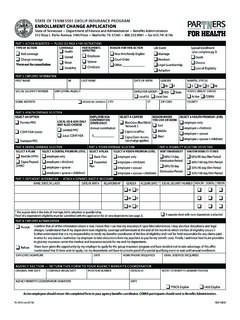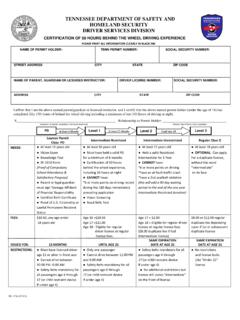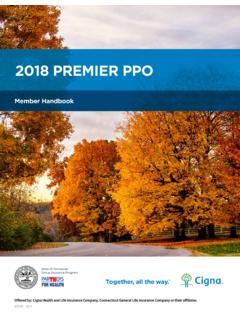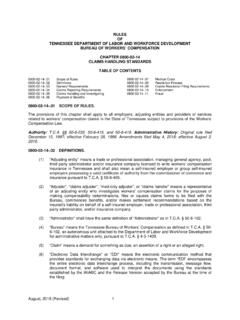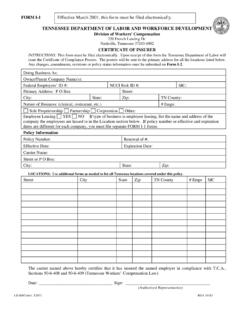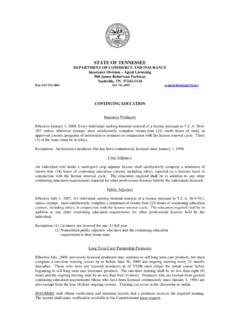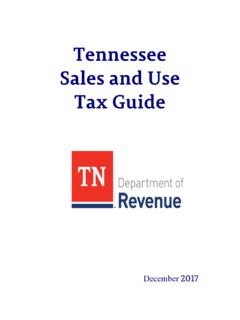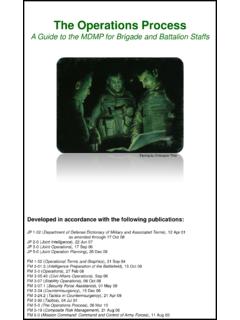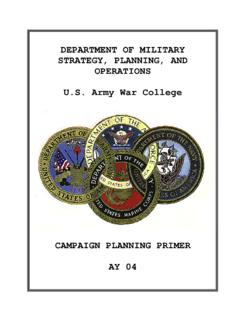Transcription of Public Water System Emergency Operations Plan …
1 Public Water System Emergency Operations plan guidance document Tennessee Department of Environment and Conservation Division of Water Supply October, 2007 i TABLE OF CONTENTS Page Section I. Introduction ..1 A. Protecting the Public Health ..1 B. Requirements for an Emergency Operations plan .. 1-2 C. State FOIA Law for Water System Information ..2 D. How to Use this Guide .. 2-4 Section II. Emergency planning Process .. 4-35 A. Overview of an Emergency Management planning Process .. 4-8 B. Preliminary Steps .. 9-12 1. planning Partnerships ..9 2. Existing Policies, Plans, Procedures .. 10-11 3. Mission Statement .. 11-12 C. Eight Elements of an Emergency Operations plan .. 12-26 1. System Specific Information .. 12-15 a. Water System Information .. 12-13 b. Maps and Critical Information .. 13-14 c. Water Source .. 14 d. Water Treatment Processes .. 15 e. Distribution System .. 15 f. Pumping Facilities.
2 15 g. Storage Facilities .. 15 h. SCADA System .. 15 i. Chemical Inventory .. 15 j. Materials/Parts Inventory .. 15 k. Critical Customers .. 15 l. Largest Customers .. 15 m. Security Features .. 15 n. Communication Equipment .. 15 o. Office Computer Equipment .. 15 2. Roles and Responsibilities .. 15-16 a. Chain of Command .. 15-16 b. Emergency Response Coordinator .. 16 c. Incident Command System .. 16 3. Communication Procedures .. 17-21 a. Internal Contact List and Responsibilities .. 17-18 b. External Contact List .. 18-19 c. Emergency Communications plan .. 20 d. Effective Communications .. 20-21 ii 4. Personnel Safety .. 22 5. Alternate Water Sources .. 23 6. Equipment and Spare Parts .. 24 7. Property Protection .. 25 8. Water Sampling & Monitoring .. 26 D. Water Conservation and Drought Management .. 27 E. Threat Evaluation .. 27-28 F. Follow-up EOP Activities .. 29-30 1. EOP Approval and Review Date .. 29 2. EOP Distribution .. 29 3.
3 Training Exercises .. 30 G. Emergency Action Plans .. 30-34 1. Response to Vulnerability Assessment and Terrorist Threats .. 30 2. Natural Disasters .. 31 3. Accidental Events .. 31 4. Human-caused Events .. 31 Glossary .. 35-40 References and Links .. 41-44 Appendix A. EOP Templates .. A-1 to A-35 Emergency Operations planning Partners .. A-1 Emergency Policies, Plans and Procedures .. A-2 Mission Statement and Emergency planning Goals .. A-3 Water System Information .. A-4 Maps and Critical Information .. A-5 Surface Water Source .. A-6 Well Water Source .. A-7 Purchased Water Source .. A-8 Spring Water Source .. A-9 Water Treatment Processes .. A10 Distribution System .. A-11 Pumping Facilities .. A-12 Storage Facilities .. A-13 SCADA or Automated Systems .. A-14 Chemical Inventory .. A-15 Materials/Parts Inventory .. A-16 Critical Customers .. A-17 Largest Customers .. A-18 Security Features .. A-19 Communication Equipment .. A-20 Office Computers and Equipment.
4 A-21 Chain of Command .. A-22 Water System Contact List .. A-23 iii External Contact List .. A-24 Emergency Communications plan .. A-25 Public Communications Guidelines .. A-26 Personnel Safety Checklist .. A-27 Alternate Water Sources .. A-28 Equipment and Spare Parts .. A-29 Property Protection Guidelines .. A-30 Water Sampling Plans .. A-31 Threat Identification Checklist .. A-32 EOP Approval List .. A-33 EOP Distribution List .. A-34 EOP Training Schedule .. A-35 Appendix B Action plan Template .. B-1 Appendix C Outline of EOP Requirements .. C-1 to C-4 Appendix D Boil Water Notice .. D Appendix E Preparing Tank Trucks .. E-1, E-2 1 Section 1. INTRODUCTION A. Protecting the Public Health The mission of every Public Water System is to provide safe and reliable drinking Water to the community. The Water supply must be of consistently high quality for drinking purposes and in compliance with federal and state Water quality standards. The Water must be delivered in adequate quantity and at adequate pressure to serve all domestic, commercial and fire protection needs (where required) of the service area.
5 An Emergency Operations plan * (EOP) identifies natural disasters and other emergencies that may strike the Water System . The EOP takes into account the risk associated with various emergencies, identifies available resources, and provides a tool for decision makers to use in mitigating the impacts of an Emergency . The EOP assists the Water System in responding quickly and effectively to an Emergency . A carefully planned EOP will reduce property damage, minimize downtime, prevent illness, save lives, and reduce System liability. Emergency response planning is an essential part of managing a Public Water System . An EOP includes specific response actions to routine operating emergencies (line break, power outage, mechanical failure, Water contamination), natural disasters (tornado, flood, earthquake, ice storm, drought), accidents (fire, chemical spill, explosion), intentional man-made acts (vandalism, terrorism, threats), or any major catastrophic incident that causes casualties, damage or disruption to the Water System .
6 For Water systems that have performed a vulnerability assessment (VA), the EOP should include response actions to potential threats and malevolent acts identified in the Water System s VA. These threats/acts could include sabotage/contamination, physical destruction, computer or System Control and Data Acquisition (SCADA) attacks and hazardous chemical releases. Tennessee Water systems understand the vital role they play in the health and well being of their community and customers. Each Water System constitutes a critical piece of the local infrastructure and economy. The Water System will create an EOP that will defend against acts that could potentially disrupt or endanger the Water supply. * The Tennessee Division of Water Supply (DWS) defines a document that prepares for an Emergency response as an Emergency Operations plan . The Environmental Protection Agency (EPA) refers to this document as an Emergency Response plan (ERP) . B. Requirements for an Emergency Operations plan The Tennessee Division of Water Supply (DWS) requires each community Water System to have an Emergency Operations plan : Rules of Tennessee Department of Environment and Conservation, Bureau of Environment, Division of Water Supply, Chapter (7).
7 All community Water systems shall prepare an Emergency Operations plan in order 2 to safeguard the Water supply and to alert the Public of unsafe drinking Water in the event of natural or man-made disasters. After the attack of September 11, 2001, the federal government amended the Safe Drinking Water Act (SDWA) to add regulations on Emergency preparedness for utilities, including community Water systems. The BioTerrorism Act of 2002 added amendments to the Safe Drinking Water Act that required the revision of Water System Emergency response plans to incorporate the results of the Water System s vulnerability assessment. The Terrorism Act required that Emergency response plans include plans, procedures, and the identification of equipment that can be used in the event of a terrorist or other intentional attack on the Water System . C. State FOIA Law for Water System Information The Terrorism Prevention and Response Act of 2002 amended Tennessee Code Annotated to exempt certain utility records from the Freedom of Information Act (FOIA).
8 Tennessee Code Annotated, Section 10-7-504(a), allows Vulnerability Assessments and certain other Water security information to be kept confidential: (21) (A) The following records shall be treated as confidential and shall not be open for Public inspection: (i) Records that would allow a person to identify areas of structural or operational vulnerability of a utility service provider or that would permit unlawful disruption to, or interference with, the services provided by a utility service provider; (ii) All contingency plans of a governmental entity prepared to respond to or prevent any violent incident, bomb threat, ongoing act of violence at a school or business, ongoing act of violence at a place of Public gathering, threat involving a weapon of mass destruction, or terrorist incident. The Water System should decide which sections of the EOP contain sensitive information (records or contingency plans as defined in Section 10-7-504(a)). These sections of the EOP should be stored under lock in a secure place.
9 Sensitive maps and/or confidential sections should be distributed on a need-to-know basis in an Emergency . The EOP and all referenced sections must be readily accessible in an Emergency . Implement a procedure that enables, at minimum, the Emergency Response Coordinator (ERC) and two alternates, to access any secured EOP documents. D. How to Use this Guide The purpose of this guide is to present the requirements for preparing and/or updating an Emergency Operations plan and to assist Water systems in meeting those 3 requirements. The EOP is a living document and should be reviewed and updated every two years, when there is a change to the Water System configuration, or when required by state or federal regulations. This EOP guidance document is written in general terms for all Water systems. It should be modified to fit the specific Emergency planning needs of each Water System . Section II begins with an Overview that summarizes the process of Emergency management planning .
10 Section II outlines the eight basic elements of Emergency response planning and in addition, includes templates completed for a fictional Middletown Water System . These examples are for illustration only. Any similarities in the names used in Middletown Water System examples to people in real life are coincidental. Appendix A contains 35 templates that may be used for completing or updating your EOP. Other Emergency response planning methods or formats are acceptable for the creation of an EOP. It is not a requirement to use the templates provided in this guidance document as long as the EOP contains the DWS requirements and is submitted in a format approved by DWS. (See Appendix C for Outline of EOP Requirements.) Copies of this Emergency Operations planning Guide are available from the Tennessee Department of Environment and Conservation Field Offices (EFO) or the Nashville Central Office (NCO). Mail requests to the Division of Water Supply, TDEC, 6th Floor, L&C Tower, 401 Church Street, Nashville, TN 37243-1549.
